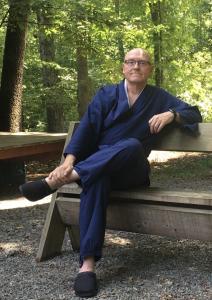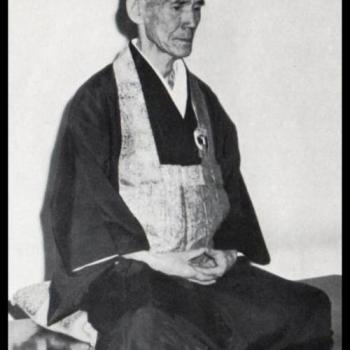In our recently concluded summer study session through the Vine of Obstacles Zen, we explored “Zen Conduct” through Dōgen’s teaching in “Guidelines for Studying the Way.” At the same time, I’ve been playing around with translating some bits of Dōgen from his Eihei Koroku (Dōgen’s Extensive Record), looking again at some of the sections that have been most meaningful to me over the years, as I highlighted in my recent post: Whole-Body Little Dog: New Translations of Two Old Dōgen Poems. (1) The dharma hall discourse that I’ve translated below is much about “Zen Conduct” and the “outward” signs of awakening.
For this dharma hall discourse, I’ve numbered the sentences for citation purposes. My brief comments follow:
Dogen’s Extensive Record v1.72:
- Going up to the hall, [Dōgen] said, “Right now, clouds and water community, is there someone who gets it?”
- At that time, a monk stepped forward and bowed.
- The teacher said, “Affirmation is exactly affirmation. Only [you are] not yet there.”
- The monk said, “What single thing is there to get?”
- The teacher said, “[I] know [your] feelings are agitated.”
- Then the teacher said, “How is a person that gets it?”
- After a long pause, [the teacher] said, “Bodymind upright, the sound of the voice is lofty.”
Click here to support my Zen teaching practice via Patreon. Translations and writings like this are one facet of this work.
Sentence 1
First, a general comment: this is an unusual dharma hall discourse in Dōgen’s Record in that it includes, indeed hinges on, an interaction with a student. Most other records from Zen masters in the classical period have a many such teacher-student interactions, but inexplicably, Dōgen’s Record has little. Perhaps there were such interactions that were not recorded, or perhaps Dōgen’s style was to lay it out there and step down from the teaching seat.
That is not to say that Dōgen held himself aloof from his students. We know from his recorded interactions with both Koun Ejō and Tetsu Gikai that he met them intimately, but perhaps not in verbal exchanges during dharma hall discourses.
Second, Dōgen’s inquiry in this short discourse has long struck me as inspiringly clear and powerful: “Is there someone who gets it?” “Yes” or “No” are just falling into the secondary.
“Is there someone who gets it?”
Now, according to the Post Meiji Soto Orthodoxy (PMSO)™, everytime anyone sits zazen, everyone gets it. But when they don’t, they don’t. If that was Dōgen’s view, why would he raise this question and why wouldn’t all the monks just run to the zendo and pull their legs up into full lotus?
Sentence 2
I love this guy for stepping up and bowing. Well, it’s also a bit of a stinky replay of Huìkě in the cave with Bodhidharma, so even while loving it, I might shout, “Stop the Zen antics already!” Or “What is your way?”
Sentence 3
And to paraphrase Dōgen’s comment – there is getting it, but this ain’t it.
Sentence 4
The monk persists. You go monk! Afterall, aren’t we full and complete from the beginningless beginning? If so, what is there to get? Turnabout is just turnabout and fairness isn’t the issue – it’s “Is there someone who gets it?”
Sentence 5
“[I] know [your] feelings are agitated” is a provisional translation of this difficult line (師云、情知泱「得。師乃云). Dōgen seems to be saying something like “I see you, dude. I know who you are.”
Sentence 6
Dōgen refines the question for the monk: “Is there someone who gets it?” becomes “How is a person that gets it?” Dōgen invites the monk and the assembly too, presumably, to share how they actually know if someone like them, for example, gets it.
The assembly has no response.
Sentence 7
So after a long pause, with Dōgen waiting for someone to show one of the many ways how one is who gets it, Dōgen speaks. And in so doing, he focuses not on the content of such a response, but on the so-called inner state of the practitioner and how it is manifest in whatever response they might have. While sitting upright, Dōgen says with what must have been a lofty voice, “Bodymind upright, the sound of the voice is lofty.”
What I’ve translated “lofty” (高), by the way, is “high” or “high pitched” or “of high quality.” Or “lofty.” I assume here that Dōgen isn’t centering sopranos, but is referring to the quality of the voice that is an expression of the upright bodymind, so I’ve gone with “lofty.”
To sum up
In this dharma hall discourse, Dōgen clearly points to the work that can be done in the Great Way. Elsewhere, he says “One-pointed diligent effort (專一功夫) precisely distinguishes the way.” In this discourse, he meets a monk and the assembly through his bodymind presentation, offering them (and us) the upright truth.
(1) For other versions of what I’ve translated in this post this see Dogen’s Extensive Record: A Translation of the Eihei Koroku or Thomas Cleary’s Eihei Koroku I-V, #69.













